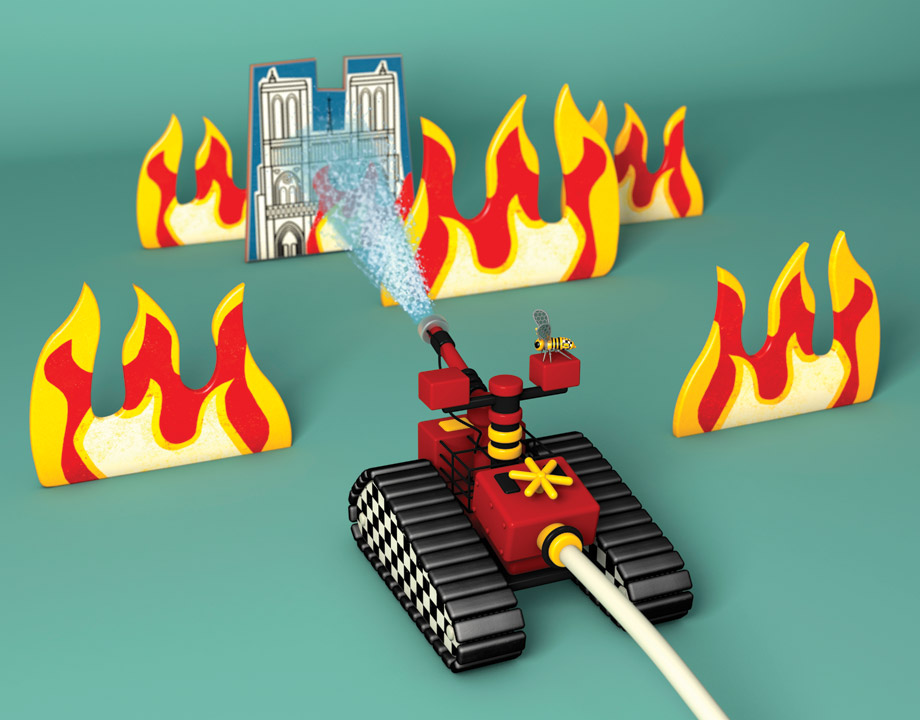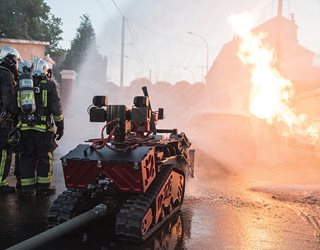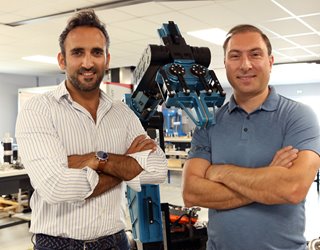Robot Firefighter That Saved Lives
Robot Firefighter That Saved Lives


Shark Robotics’ Colossus robot helped preserve Notre Dame and save the lives of Paris firefighters. Image: Richard Borge
This past April, a raging fire that consumed the roof of Paris’s famed Notre Dame Cathedral captured the world’s attention. Flames licked the centuries-old church, felled its spire, and threatened to bring down the entire structure.
Firefighters, hampered by the sheer size of the building and the fire, rolled a 21st Century tool into the nave directly under the burning roof where it was deemed too dangerous for them to work. A firefighting robot named Colossus maintained its position for eight hours, spraying water from its hose at the fire above.
Its success under such circumstances dramatically illustrated how robots are becoming an essential tool in the workplace, from the manufacturing floor to the most unstable and dangerous spaces.
Colossus was developed by Shark Robotics, a three-year-old French startup based in the southwestern city of La Rochelle.
From the beginning, the firm’s goal was to focus on development of robust robots that could be used by first responders, the military, or anyone tasked with working in dangerous areas.
With experience in the French military and defense ministry, co-founder Cyril Kabbara said the goal was to focus on producing a robust platform for a robotic tool.
Further Reading: The 7 Coolest Rescue Robots Tackle Almost Any Disaster
“It’s a good thing to embed intelligence into a platform but if it is inefficient there will be a problem,” he said. “When we started the company, 90 percent of robotics companies were focused on software. Nobody focused on the platform. We chose to go in the other direction.”
To do that, the firm relies on Jean-Jacques Topalian, co-founder and a mechanical engineer who leads design and production.
“We focus on the mechatronics side to develop a powerful platform with open architecture so we can integrate software based on the needs of the user,” Kabbara said. “We focused on the drive train and battery. We developed our own batteries, with a patent to provide efficient lithium ion batteries that will not explode under high heat.”
The firm built its first robot, Colossus, on an aluminum frame to be used by the military in mine detection. They adapted it for firefighting and it is used by numerous fire brigades in France and Belgium.
Colossus and Shark’s seven other robots are built in its own shop where engineers and technicians produce everything from the drivetrain and frame to tracks or wheels. Kabbara said the firm works closely with customers to evaluate their specific needs and can turn out a robot in 90 days.
Further Reading: 5 Most Influential Robots in History
The biggest challenge is in the testing phase, Kabbara said. “It is important to know and understand what the end user needs, the situation and the context of the situation in which to deploy. When you understand that it is easier to manufacture.”
Just as challenging sometimes is getting the user to accept the robot as a tool. “Firefighters were looking at us, and saying this is going to lose my job,” he said. “We have to explain that the robotic solution is a tool and it needs humans to be in the loop. Artificial intelligence is important, but with such a quick situation you still need the brain of a human to be behind it.”
John Kosowatz is senior editor.
Learn More About Emerging Tech Awards 2019
Firefighters, hampered by the sheer size of the building and the fire, rolled a 21st Century tool into the nave directly under the burning roof where it was deemed too dangerous for them to work. A firefighting robot named Colossus maintained its position for eight hours, spraying water from its hose at the fire above.
Its success under such circumstances dramatically illustrated how robots are becoming an essential tool in the workplace, from the manufacturing floor to the most unstable and dangerous spaces.
Colossus was developed by Shark Robotics, a three-year-old French startup based in the southwestern city of La Rochelle.
From the beginning, the firm’s goal was to focus on development of robust robots that could be used by first responders, the military, or anyone tasked with working in dangerous areas.
With experience in the French military and defense ministry, co-founder Cyril Kabbara said the goal was to focus on producing a robust platform for a robotic tool.
Further Reading: The 7 Coolest Rescue Robots Tackle Almost Any Disaster
“It’s a good thing to embed intelligence into a platform but if it is inefficient there will be a problem,” he said. “When we started the company, 90 percent of robotics companies were focused on software. Nobody focused on the platform. We chose to go in the other direction.”
To do that, the firm relies on Jean-Jacques Topalian, co-founder and a mechanical engineer who leads design and production.
“We focus on the mechatronics side to develop a powerful platform with open architecture so we can integrate software based on the needs of the user,” Kabbara said. “We focused on the drive train and battery. We developed our own batteries, with a patent to provide efficient lithium ion batteries that will not explode under high heat.”
The firm built its first robot, Colossus, on an aluminum frame to be used by the military in mine detection. They adapted it for firefighting and it is used by numerous fire brigades in France and Belgium.
Colossus and Shark’s seven other robots are built in its own shop where engineers and technicians produce everything from the drivetrain and frame to tracks or wheels. Kabbara said the firm works closely with customers to evaluate their specific needs and can turn out a robot in 90 days.
Further Reading: 5 Most Influential Robots in History
The biggest challenge is in the testing phase, Kabbara said. “It is important to know and understand what the end user needs, the situation and the context of the situation in which to deploy. When you understand that it is easier to manufacture.”
Just as challenging sometimes is getting the user to accept the robot as a tool. “Firefighters were looking at us, and saying this is going to lose my job,” he said. “We have to explain that the robotic solution is a tool and it needs humans to be in the loop. Artificial intelligence is important, but with such a quick situation you still need the brain of a human to be behind it.”
John Kosowatz is senior editor.
Learn More About Emerging Tech Awards 2019






